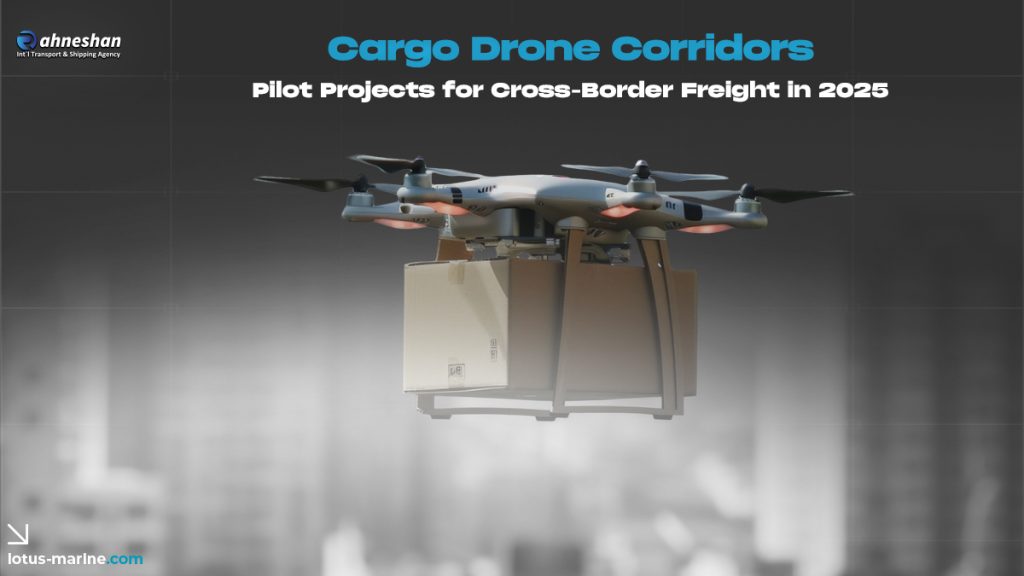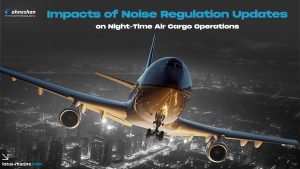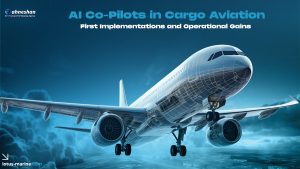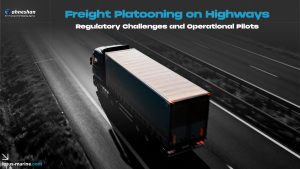Introduction
In 2025, supply-chain and logistics leaders are under increasing pressure to move goods faster, with lower emissions, and across more complex geographies. One frontier in this transformation is the establishment of dedicated cargo drone corridors—designated low-altitude aircraft routes enabling unmanned aerial vehicles (UAVs) to carry freight across borders, between hubs, or along critical logistics axes. For freight forwarders, shipping companies and B2B logistics operators, understanding how these corridors work—and how they can leverage them—could unlock new service propositions, faster transit, and cost differentiation.
What are Cargo Drone Corridors?
Cargo drone corridors refer to pre-defined aerial routes or zones (often low to medium altitude) where unmanned cargo aircraft can operate safely and efficiently, including across national borders or between logistics hubs, subject to regulatory approval, airspace management and infrastructure support. These corridors often include:
-
Beyond Visual Line of Sight (BVLOS) operations for cargo UAVs.
-
Droneports or hubs at origin/destination for loading/unloading.
-
Integration with airspace traffic management, geo-fencing, safety and reliability standards.
-
Infrastructure and regulatory coordination across borders (when cross-border freight).
For example, the Dronamics project in Europe is developing a cargo drone “airline” that intends cross-border middle-mile transport via UAVs. CORDIS+2Autonomy Global –+2 In another case, the Detroit Region Aerotropolis Development Corp. in Michigan is exploring drone freight corridors aligned with rail networks rather than roads. SBN Detroit+1
Thus, for freight movement beyond simple last-mile drone delivery, drone corridors hold promise for medium-distance, cross-hub or cross-border shipments.
Key Benefits for Freight Forwarders & B2B Logistics
1. Reduced transit time and congestion avoidance
Cargo drones flying dedicated corridors avoid road congestion, border-delays, traffic jams and port/terminal bottlenecks. They can deliver medium-weight freight (hundreds of kilograms) more quickly than many road/rail options, especially in cross-border or remote routes.
2. Sustainability & emissions advantage
Electric or hybrid UAVs generate fewer emissions compared to heavy trucks or smaller aircraft. This supports green-logistics commitments from B2B clients. For example, drones in 2025 are cited as “offering faster, cleaner, and more cost-efficient delivery” in analysis of drone cargo sustainability. The STAT Trade Times
3. New service-tiers & value-added offerings
Freight forwarders can offer “drone corridor express” or “priority medium-distance aerial freight” services—an overlay to standard road/sea/air shipping. This can help attract high-value B2B clients who prioritise speed and service reliability.
4. Access to difficult routes or underserved areas
In cross-border scenarios where roads or rail may be congested, politically complex or under-developed, drone corridors offer an alternative. For instance, regions with challenging terrain or regulatory friction may benefit from aerial freight alternatives.
5. Competitive differentiation
By being an early mover in interfacing with drone-freight infrastructure, forwarders can position themselves as innovative, future-ready B2B partners—not just commodity carriers.
Challenges & Backlash in 2025
1. Regulatory & cross-border complexity
Establishing drone corridors across borders involves multiple civil-aviation authorities, harmonised standards, cross-national air-space permissions, and infrastructure agreements. For example, while projects like Dronamics are advanced, they still navigate regulatory complexity. CORDIS+1
2. Payload/Distance limitations and economics
Although drone technology is improving, payload capacities and cost-efficiencies are still bounded compared to traditional freight modes. For large containers or heavy goods, drones may not yet be viable. Forwarders must assess which cargo types and routes are suitable.
3. Infrastructure & investment requirements
Cargo drone corridors require droneports, charging/maintenance infrastructure, air-traffic management systems, and integration into the wider logistics network. These investments may limit early adoption to specific corridors or high-value routes.
4. Air-space safety, community acceptance & risk
Low-altitude aerial operations raise issues around noise, risk of incidents, public perception and legal liability. Routes crossing inhabited areas or sensitive infrastructure may face opposition. For example, the Michigan corridor project needed community and municipal collaboration to succeed. SBN Detroit
5. Operational integration with multimodal logistics
Freight forwarders must integrate drone-corridor options into their routing, load-planning and quotes. This means overlaying drone-leg options, handling transfers to/from drones, warehousing at hubs, and synchronising with road/sea legs—adding complexity.
Strategic Recommendations for Freight Forwarders & Shippers
-
Identify key corridors: Map trade-lanes you serve where road/rail are congested or crossing borders is a bottleneck. Investigate whether drone-corridor pilots or infrastructure exist (or are being planned) along these lanes.
-
Segment cargo types: Offer drone-corridor service for medium-weight, high-value, time-sensitive freight—not bulk goods initially. This allows proof-of-concept.
-
Partner with drone-logistics players: Align with drone-UAV service providers or airports developing droneports. Being part of the ecosystem early positions you to capture the value-chain.
-
Build in cost- and service-differentiation: In your B2B proposals, highlight the drone-corridor option: faster transit, less border delay, reduced carbon footprint. Show pricing tiers accordingly.
-
Prepare operationally: Ensure your systems can integrate a drone leg: loading/unloading at drone hub, documentation transfers, regulatory compliance, data sharing. Training, IT and process changes will matter.
-
Monitor regulation & scalability: Keep abreast of civil-aviation regulations, BVLOS approval, air-space changes and local policies. Early-adoption risks might be higher, but the first-mover potential is valuable.
-
Marketing narrative: Use this innovation as a differentiator: “Your global freight partner with access to aerial corridor express routes” reinforces you are forward-looking and service-centric.
Outlook & Best Practices for 2025 and Beyond
-
The concept of drone-based freight corridors is transitioning from pilot stage to commercialisation. Projects like Dronamics in Europe are paving the way. CORDIS+1
-
Expect the value proposition to grow when drone technology scales (greater payloads, longer range, better cost-efficiency).
-
Logistics companies that integrate drone-corridor services will gain early-mover advantage in certain trade-lanes—especially cross-border or time-sensitive shipment corridors.
-
Standardisation and regulatory frameworks will accelerate adoption. Once homologated UAV freight corridors are in place, forwarders can treat them like any other freight mode (road, rail, air).
-
Regionally, for corridors such as the Caspian Sea, Caucasus, Middle East or Central Asia, forwarders should monitor where drone-infrastructure investment is happening and consider pilot participation or route design accordingly.
Frequently Asked Questions (FAQ)
Q1. What kinds of freight are suitable for cargo drone corridors?
A1. Generally, time-sensitive, medium-weight (hundreds kg rather than tonnes) goods—such as spare parts, high-value components, medical supplies, ecommerce/consumer goods where speed matters more than volume. Bulk freight or standard containerised goods still rely on traditional modes.
Q2. How cross-border are these drone corridors in practice in 2025?
A2. Some projects are explicitly building cross-border capability. For example, Dronamics aims to operate between European countries via UAVs and establish droneports globally. CORDIS However, many corridors are still domestic or within a country—cross-border regulatory harmonisation remains a challenge.
Q3. What transit-time advantage can you expect?
A3. While specific numbers vary, drone corridors avoid road/rail congestion and border-delays and can fly more direct routes. For middle-mile freight (50-300 km) there can be substantial time savings—especially in regions where surface infrastructure is congested or inefficient.
Q4. What do logistics companies need to do now to prepare?
A4. Map potential corridors, collaborate with drone-service operators, adapt IT/transport management systems to include drone-leg options, segment suitable freight, begin pilots, and monitor regulatory changes. Build change-management for operations and training.
Q5. Is this technology ready for large-scale freight movement?
A5. Partially—pilots are well underway and medium-scale operations are emerging, but full large-volume freight movement via drone corridors is still developing. Forwarders should adopt a hybrid strategy: use drone corridors where advantageous, while continuing established modes for majority of cargo.
Conclusion
For B2B freight forwarders and logistics companies, the emergence of dedicated cargo drone corridors in 2025 represents a new frontier in freight-mode choice. While challenges remain—regulation, payload economics, infrastructure investment—the opportunity to offer express aerial freight across borders or between hubs can become a meaningful differentiator.
By proactively integrating drone-corridor options into your service portfolio, you can position your company as a strategic logistics partner that is ready for the next wave of mobility. The companies that adapt early, build ecosystem partnerships and offer differentiated services will be better placed to attract high-value B2B clients and secure long-term contracts in a rapidly evolving market.






